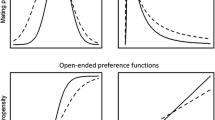Summary
Female choice, identified as a major force in sexual selection theory, has recently been demonstrated in a number of species. These tests concentrated on simultaneous choice situations although females have to compare males sequentially in most territorial species, which is the more demanding task. Here it is shown that female three-spined sticklebacks, Gasterosteus aculeatus L., rate sequentially presented males according to their brightness. With increasing costs of sampling the females become less choosy. Furthermore, a male's attractiveness has a significant effect on the female's rating of the next male; a given male is rated higher when preceded by a duller male than by a brighter one and vice versa. Female sticklebacks use a stochastic decision rule in sequential mate choice that is attuned to the attractiveness of the present and previously encountered male. This demonstration of a “previous male effect” not only indicates an efficient mechanism for finding the best of a number of males but also extends the applicability of sexual selection theory.
Similar content being viewed by others
References
Andersson M (1982) Female choice selects for extreme tail length in a widowbird. Nature 299:818–820
Arak A (1988) Female mate selection in the natterjack toad: active choice or passive attraction? Behav Ecol Sociobiol 22:317–327
Bradbury JW, Andersson MB (eds) (1987) Sexual selection: testing the alternatives. Wiley, Chichester
Bradbury JW, Gibson RM (1983) Leks and mate choice. In: Bateson P (ed) Mate choice. Cambridge University Press, Cambridge, pp 109–138
Brown L (1981) Patterns of female choice in mottled sculpins (Cottidae, Teleostei). Anim Behav 29:375–382
Catchpole CK, Dittami J, Leisler B (1984) Differential responses to male song repertoires in female songbirds implanted with oestradiol. Nature 312:563–564
Dale S, Amundsen T, Lifjeld JT, Slagsvold T (1990) Mate sampling behaviour of female pied flycatchers: evidence for active mate choice. Behav Ecol Sociobiol 27:87–91
Darwin C (1871) The descent of man, and selection in relation to sex. Murray, London
Fisher RA (1930) The genetical theory of natural selection. Clarendon Press, Oxford
Gibson RM (1990) Relationships between blood parasites, mating success and phenotypic cues in male sage grouse Centrocercus urophasianus. Am Zool 30:271–278
Gronell AM (1989) Visiting behaviour by females of the sexually dichromatic damselfish, Chrysiptera cyanea (Teleostei: Pomacentridae): a probable method of assessing male quality. Ethology 81:89–122
Hamilton WD, Zuk M (1982) Heritable true fitness and bright birds: a role for parasites? Science 218:384–387
Houde AE, Endler JA (1990) Correlated evolution of female mating preferences and male color patterns in the guppy Poecilia reticulata. Science 248:1405–1408
Iersel JJA van (1953) An analysis of the parental behaviour of the male three-spined stickleback (Gasterosteus aculeatus L.). Behav Suppl 3:1–159
Janetos AC (1980) Strategies of female mate choice: a theoretical analysis. Behav Ecol Sociobiol 7:107–112
Janetos AC, Cole BJ (1981) Imperfectly optimal animals. Behav Ecol Sociobiol 9:203–209
Kirkpatrick M (1982) Sexual selection and the evolution of female choice. Evolution 330:1–12
Klump GM, Gerhardt HC (1987) Use of non-arbitrary acoustic criteria in mate choice by female gray tree frogs. Nature 326:286–288
Kodric-Brown A (1985) Female preference and sexual selection for male coloration in the guppy (Poecilia reticulata). Behav Ecol Sociobiol 17:199–205
Kynard BE (1978) Breeding behavior of a lacustrine population of threespine sticklebacks (Gasterosteus aculeatus L.). Behaviour 67:178–207
Lande M (1981) Models of speciation by sexual selection on polygenic traits. Proc Natl Acad Sci USA 78:3721–3725
Majerus MEN, O'Donald P, Weir J (1982) Female mating preference is genetic. Nature 300:521–523
McLennan DA, McPhail JD (1990) Experimental investigations of the evolutionary significance of sexually dimorphic nuptial colouration in Gasterosteus aculeatus (L.): the relationship between male colour and female behaviour. Can J Zool 68:482–492
Milinski M, Bakker TCM (1990) Female sticklebacks use male coloration in mate choice and hence avoid parasitized males. Nature 344:330–333
M∅ller AP (1988) Female choice selects for male sexual tail ornaments in the monogamous swallow. Nature 332:640–642
Moore AJ, Moore PJ (1988) Female strategy during mate choice: threshold assessment. Evolution 42:387–391
O'Donald P (1980) Genetic models of sexual selection. Cambridge University Press, Cambridge
Parker GA (1983) Mate quality and mating decisions. In: Bateson P (ed) Mate choice. Cambridge University Press, Cambridge, pp 141–166
Pomiankowski A (1987) The costs of choice in sexual selection. J Theor Biol 128:195–218
Real L (1990) Search theory and mate choice. I. Models of singlesex discrimination. Am Nat 136:376–405
Real L (in press) Search theory and mate choice. II. Mutual interaction, assortative mating, and equilibrium variation in male and female fitness. Am Nat
Ryan MJ (1985) The Túngara frog, a study in sexual selection and communication. University of Chicago Press, Chicago
Ryan MJ, Wilczynski W (1988) Coevolution of sender and receiver: effect on local mate preference in cricket frogs. Science 240:1786–1788
Seger J (1985) Unifying genetic models for the evolution of female choice. Evolution 39:1185–1193
Sevenster P (1961) A causal analysis of a displacement activity (fanning in Gasterosteus aculeatus L.). Behav Suppl 9:1–170
Sokal RR, Rohlf FJ (1981) Biometry (2nd edn) Freeman, New York
Wittenberger JF (1983) Tactics of mate choice. In: Bateson P (ed) Mate choice. Cambridge University Press, Cambridge, pp 435–447
Wootton RJ (1974a) The inter-spawning interval of the female three-spined stickleback, Gasterosteus aculeatus. J Zool (Loud) 172:331–342
Wootton RJ (1974b) Changes in the courtship behaviour of female three-spined sticklebacks between spawnings. Anim Behav 22:850–855
Wootton RJ (1976) The biology of the sticklebacks. Academic Press, London
Zuk M, Johnson K, Thornhill R, Ligon JD (1990) Mechanisms of female choice in red jungle fowl. Evolution 44:477–485
Author information
Authors and Affiliations
Additional information
Offprint requests to: T.C.M. Bakker
Rights and permissions
About this article
Cite this article
Bakker, T.C.M., Milinski, M. Sequential female choice and the previous male effect in sticklebacks. Behav Ecol Sociobiol 29, 205–210 (1991). https://doi.org/10.1007/BF00166402
Received:
Accepted:
Issue Date:
DOI: https://doi.org/10.1007/BF00166402




